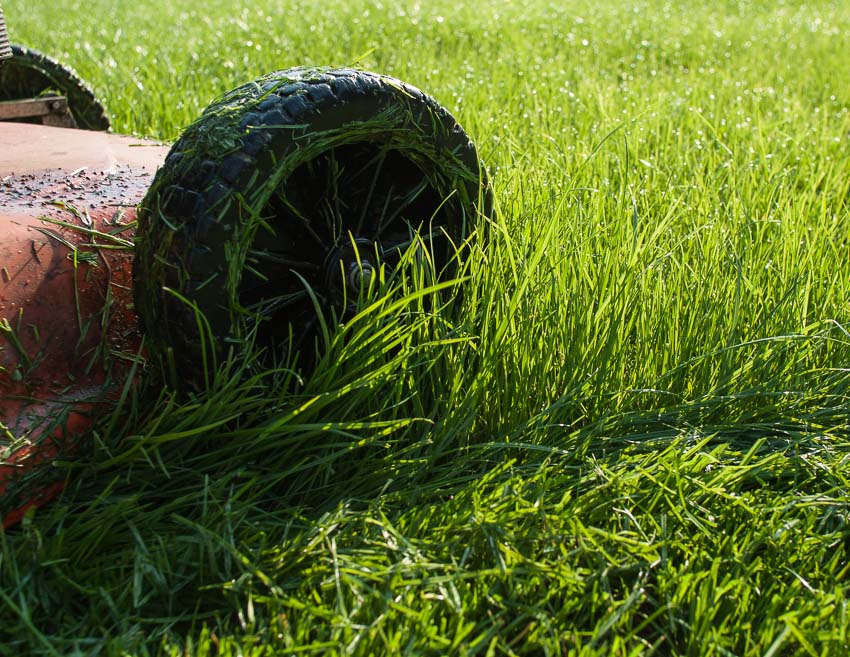It happens every season. Your grass is growing like crazy, and it rains when you finally have a day off. Mowing wet grass isn’t usually recommended, but it’s just going to keep getting longer. Should you mow your grass or wait? Discover techniques for mowing wet grass and learn why waiting might be the best option.
Understanding the Debate Around Mowing Wet Grass
“I’m waiting for the grass to dry.” It sounds like a good excuse, but are there solid reasons to back up the delay?
While many people don’t think it’s that big of a deal, cutting wet grass can damage your lawn, clog your lawn mower, and make the lawn more susceptible to disease and erosion.
Can You Cut Wet Grass?
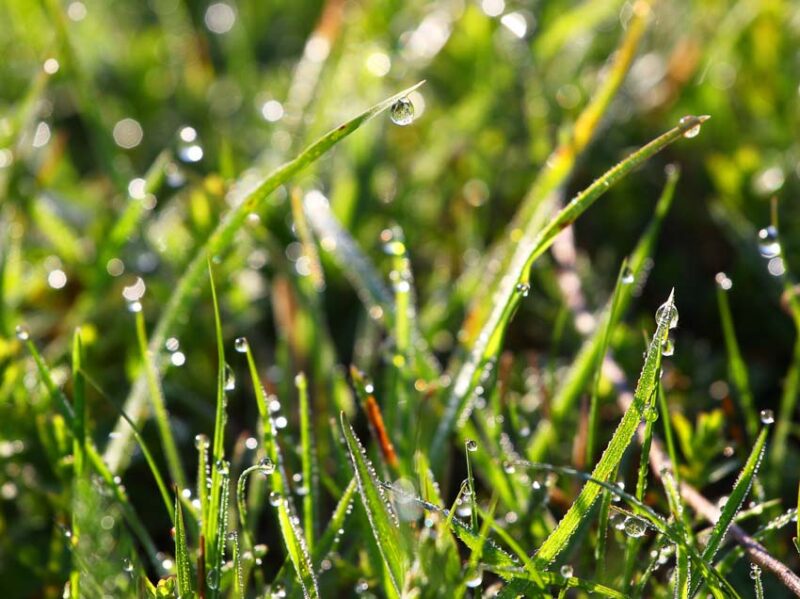
While mowing wet grass is less than ideal, it is possible and sometimes unavoidable. To help you determine if mowing your wet lawn is worth it, consider the following factors and learn more about the best techniques for mowing wet grass.
Factors to Consider Before Cutting Wet Grass
Assess your lawn and equipment. Then, ask yourself the following questions to determine if it’s worth mowing your grass when wet.
- How wet is my grass? Determine the degree of wetness of the soil and grass.
- What’s the weather forecast? Waiting may be worth waiting if it’s likely to dry up in the next few days.
- Do I have time to mow my grass later? Waiting may be a better option if you have time in your schedule.
- What type of equipment do I have? If all you have is a riding mower and your ground is soggy, it will be better to wait.
If you don’t have time in your busy schedule, hiring someone to mow your lawn weekly during the rainy season is another option.
Techniques for Mowing Wet Grass
Even though you shouldn’t cut wet grass, you can’t always avoid it. There are certain times of the year, especially in wet climates, when it’s almost impossible to find a time when your grass is dry enough to mow.
Work is another reason you might be unable to wait for your grass to dry. Most people have to mow their lawns around their work schedule, and if it’s raining all week, the weekend may be the only time to get it done.
Mowing wet grass can be the lesser of two evils, especially if your lawn is already super long. It’s only going to grow faster with the rain fueling its growth.
So, if you find yourself in this dilemma, you can do a few things to avoid damaging your lawn.
Start by testing the soil to determine how soft it is, then follow these recommendations to get the best results when mowing wet grass.
Safety First
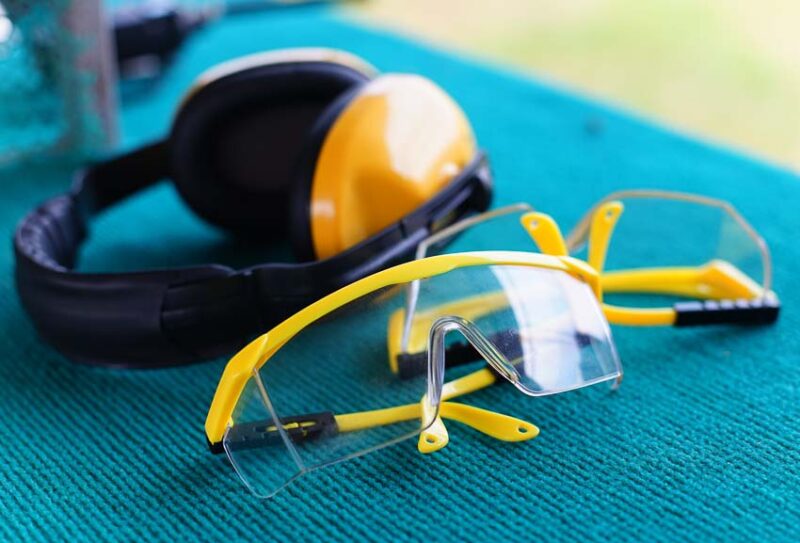
Over 80,000 mowing-related accidents yearly in the United States resulting in about 70 fatalities, making lawn mowers one of the most dangerous tools around the home.
Mowing when the grass is wet presents additional safety issues, so take your time and try to stay calm. Grass mowing presents safety hazards even under the best conditions, so safe mowing practices are critical.
- Wear protective gear and clothing
- Wear the proper shoes
- Check for objects before you start
- Avoid distractions
Use a Push Mower
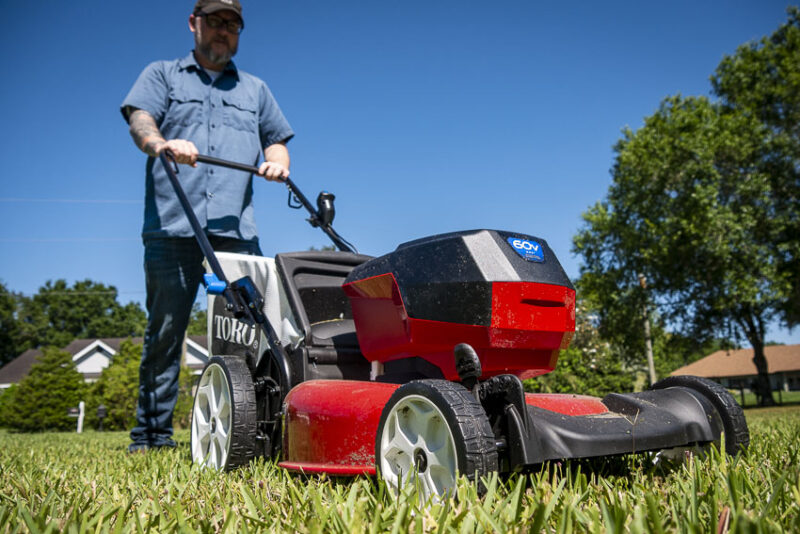
Even if you have a large yard, you’re better off mowing wet grass with a push mower. You could cause much more work for yourself with a riding lawn mower because it’s heavier and thus more likely to cause ruts in the soft ground.
Remove Lawn Striping Equipment
If your mower has a lawn striping kit, remove it before mowing a wet lawn. Striping your lawn isn’t effective when cutting wet grass, and it’s more likely to jam your mower blades.
Don’t Bag
One of the biggest problems with mowing damp grass is that it leaves clumps of grass behind, so some people recommend collecting your lawn clippings with your mower bag. However, mowing wet grass is messy, and you’re better off raking up the clumps or mowing again with the grass catcher when it’s drier.
Don’t Mulch
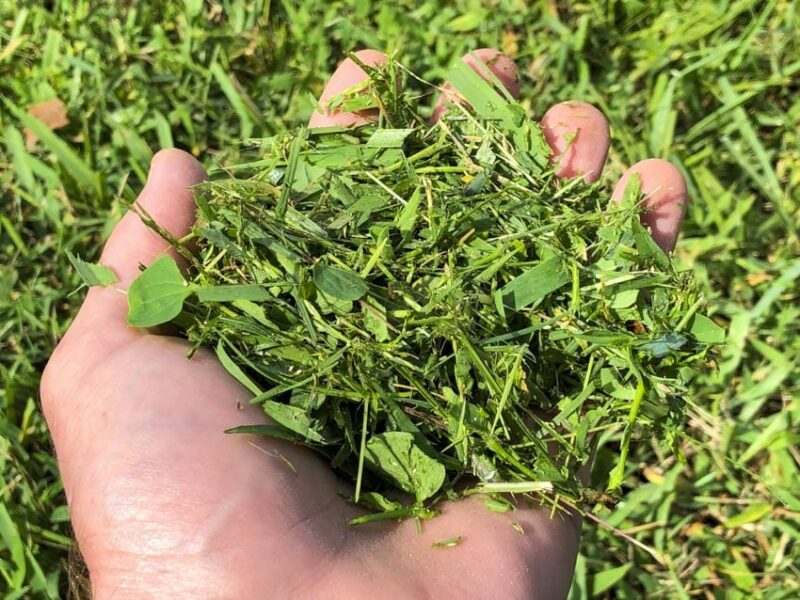
Typically, you should use mulching lawn mowers because they put nutrients back into the soil, but the side discharge is a better option for wet grass. You’ll have less clumping, and it will be easier to clean your equipment.
Set Your Blades High
Raise your wheels as high as they will go to mow your grass as tall as possible. Mowing higher than 4 inches is a good idea because cutting wet grass too short can damage your lawn.
Sharpen Your Blades
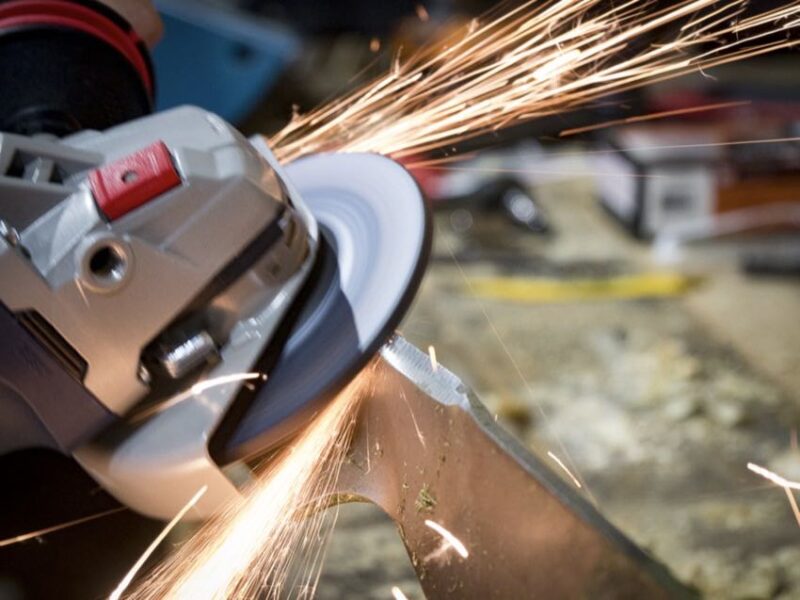
When mowing wet grass, dull blades make it easier for the mower to pull out clumps. For the best results, you should sharpen your blades before cutting.
Take Small Bites
Go slow and avoid taking too big a bite when your lawn is damp. If you use a narrower swath, overlapping your previous cut by about 50% of the previous pass, your lawn mower won’t have to work as hard. This will result in a better cut, fewer clumps, and less stress on the mower.
Stay Off Sidewalks and Driveways
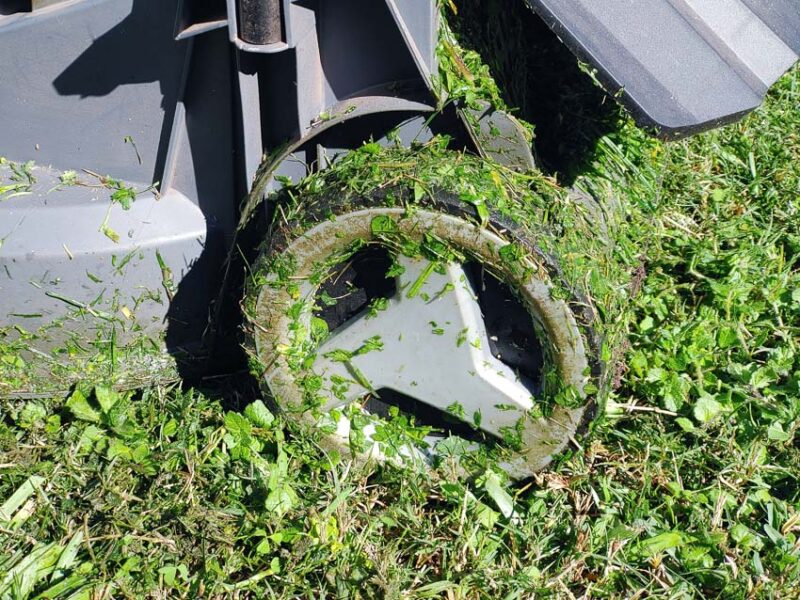
When mowing wet grass, the wheels of your lawn mower will become caked in clippings, and you’ll track the grass onto your concrete, leaving stains. It’s better to mow around the perimeter of your lawn first, then you can make turns on that pass.
Clean Your Equipment
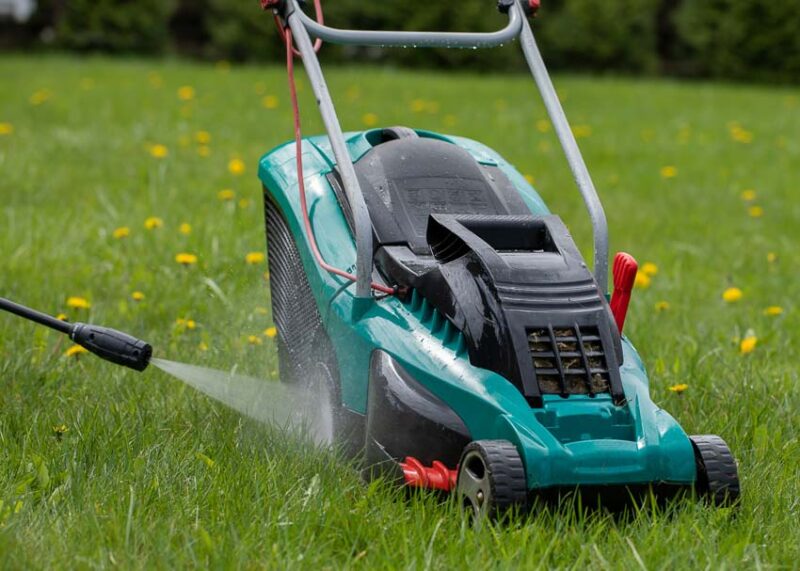
When you’ve finished mowing, clean your equipment without delay. If you don’t remove the dried grass, it’s even harder to get off later. Use the deck mower wash hose attachment for easy cleaning.
The Good and the Bad: Pros and Cons of Mowing Wet Grass
Are there any advantages of mowing grass before it dries? Learn more about the pros and cons of mowing wet grass.
Benefits of Cutting Damp Grass
There aren’t a lot of benefits to mowing wet grass, but one thing you won’t have to contend with is dust.
However, if your grass is already six inches tall, mowing it even when it’s wet might be your only option. Otherwise, it will be even harder to mow later.
Drawbacks of Cutting a Wet Lawn
Before you decide if it’s worth it to mow your wet lawn, consider the following drawbacks.
Clumping and Matting
Wet grass sticks together, and you won’t get a fresh, even cut. Instead, you’ll end up with a matted lawn, and if you don’t collect the clippings, you’ll have big clumps of grass to rake up.
More Cleanup Required
Some experts recommend using your grass catcher to collect the clumps of grass, but this means you’ll have more cleanup after you’re done mowing. You’ll also need to spray off the wheels and mower deck and use the garden hose attachment to clean the blades and underneath the mower deck.
Safety Issues
Because it’s so commonplace, many people forget how dangerous mowing can be. It’s even more unsafe when you’re mowing wet grass.
Damage to Your Mower
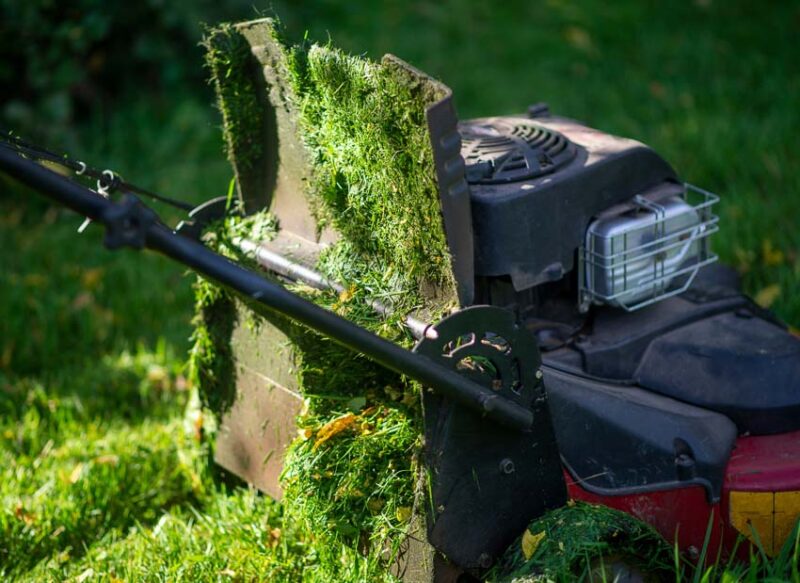
Wet grass is significantly more difficult to cut than dry grass, leading to reduced power and the potential risk of the blade becoming stuck in the grass and slowing down the motor.
Stains
Wet grass stains your clothes and footwear faster than dry grass. It can also stain your concrete paths and driveways.
Why You Should or Shouldn’t Mow Wet Grass
Lawn care professionals don’t have much of a choice when it comes to mowing wet grass. Their business model requires them to stay on a tight schedule, requiring them to mow every day, rain or shine.
For homeowners, however, there are plenty of good reasons to avoid mowing wet grass, including health implications for your lawn, safety considerations, and the impact on your lawn mower.
Health Implications for Your Lawn
Most people want their lawns to look nice, and some put considerable time, money, and effort into ensuring it stays lush and green. Because there are several ways that mowing wet grass can damage your lawn, it doesn’t make sense to mow when it’s wet.
Since dry grass stands up straight, mower blades cut it neatly. Mowing can result in an uneven shred when the grass is bent over from moisture. If the blades are dull, pulling clumps of grass out of the soft ground is easy.
Mowing wet grass spreads fungal diseases all over your yard and increases the risk of spreading weed seeds. Since it’s hard to get a clean cut with wet grass, the ripping and tearing of grass blades will make your lawn more susceptible to fungal diseases.
Because the grass clippings stick together, there is more clumping, which can smother parts of your lawn and cause excess thatch buildup. The more thatch you have, the longer your soil will drain, and your grass to dry. You’ll also have more mushrooms in your lawn.
Safety Considerations When Cutting Damp Grass
You’re more likely to slip and fall when mowing a wet lawn than a dry one. Slipping and falling can cause sprains, back injuries, and broken bones. When you factor in the additional danger of the mower blades, mowing wet grass doesn’t seem worth it.
Electric shock is another danger if you’re using an electric mower, and it’s an even more serious hazard when it’s raining. The risk of electric shock usually comes from the connections on the power cords.
If you decide to mow wet grass, take your time and wear proper footwear to avoid slipping. Also, never operate a riding lawn mower on steep terrain in wet conditions.
Impact on Your Lawn Mower
You have an investment in your lawn and personal safety, but you also have an investment in your equipment. Running a lawn mower in wet grass makes the engine work harder, which can damage it and reduce its lifespan.
Grass clippings stick to your equipment, block the blades, and block vacuums, all of which can affect the performance of your lawn mower. Exposure to moisture causes rust on your blades and mower deck. It’s even more critical to keep electric mowers dry.
Check out OPE’s maintenance tips to keep your mower going strong!
Frequently Asked Questions About Mowing Wet Grass
Does cutting wet grass damage the lawn?
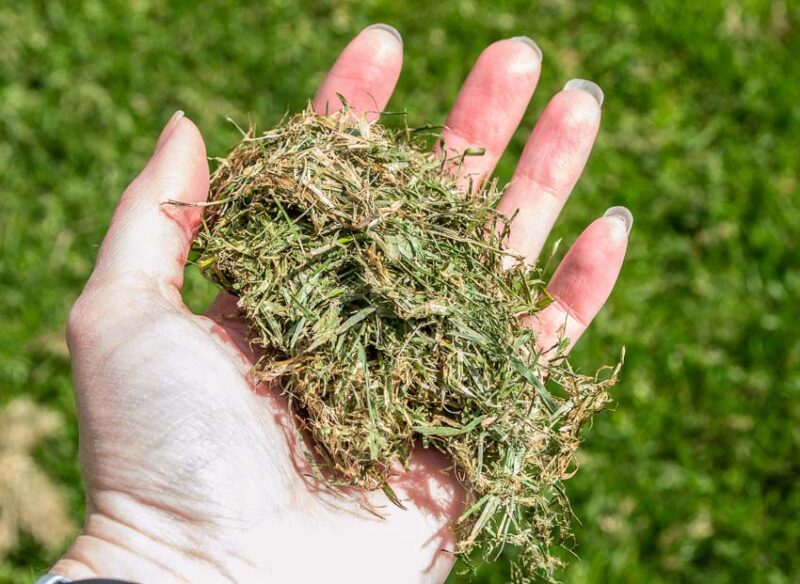
There are a few ways that mowing wet grass can damage your lawn, but the biggest problem is clumping grass. If clumps of grass stay on the lawn, they can smother it, causing patchy grass and heavy thatch.
If the ground is really soft, you could also make ruts in your lawn.
Is it dangerous to mow wet grass?
Mowing is dangerous whether your grass is wet or dry. However, when you’re mowing wet grass, it presents greater risks. Slipping and falling is more likely and especially hazardous when operating equipment with sharp, spinning blades.
Mowing is also riskier on uneven terrain when it’s wet.
How can I safely cut wet grass?
Follow safety precautions any time you mow because it’s one of the most dangerous tools around the home. Safety is more important when you’re mowing wet grass because slipping and falling becomes more problematic.
Can cutting damp grass damage my lawn mower?
Mowing wet grass makes your engine work harder, which can cause it to overheat. It will also clog the mower deck, which can stop the blades and bend them slightly. Bent blades can make your mower vibrate and ruin the bearings.
What is the best time to mow my lawn to avoid damp grass?
Usually, the best time to mow your lawn is between 8 am and 10 am, after the dew has dried. But if it rained overnight, you may need to wait until later in the day to give it a chance to dry out more.
However, if your grass is tall and more rain is forecasted in the weather, you may need to mow as soon as possible.
Learn everything you need to know about different types of lawn grasses. Explore OPE‘s guides to Fescue, Kentucky Bluegrass, Perennial Ryegrass, Zoysia, Bermuda, Buffalo, St. Augustine, Bahia, and Centipede grass.

